Immigrants from Western Europe vs Assyrian/Chaldean/Syriac Community Comparison
COMPARE
Immigrants from Western Europe
Assyrian/Chaldean/Syriac
Social Comparison
Social Comparison
Immigrants from Western Europe
Assyrians/Chaldeans/Syriacs
7,245
SOCIAL INDEX
69.9/ 100
SOCIAL RATING
127th/ 347
SOCIAL RANK
7,301
SOCIAL INDEX
70.5/ 100
SOCIAL RATING
124th/ 347
SOCIAL RANK
Assyrian/Chaldean/Syriac Integration in Immigrants from Western Europe Communities
The statistical analysis conducted on geographies consisting of 109,210,154 people shows a strong positive correlation between the proportion of Assyrians/Chaldeans/Syriacs within Immigrant from Western Europe communities in the United States with a correlation coefficient (R) of 0.727. On average, for every 1% (one percent) increase in Immigrants from Western Europe within a typical geography, there is an increase of 0.038% in Assyrians/Chaldeans/Syriacs. To illustrate, in a geography comprising of 100,000 individuals, a rise of 1,000 Immigrants from Western Europe corresponds to an increase of 37.7 Assyrians/Chaldeans/Syriacs.

Immigrants from Western Europe vs Assyrian/Chaldean/Syriac Income
When considering income, the most significant differences between Immigrants from Western Europe and Assyrian/Chaldean/Syriac communities in the United States are seen in householder income under 25 years ($52,957 compared to $65,329, a difference of 23.4%), wage/income gap (27.8% compared to 31.0%, a difference of 11.7%), and per capita income ($50,065 compared to $45,195, a difference of 10.8%). Conversely, both communities are more comparable in terms of median household income ($91,936 compared to $91,991, a difference of 0.060%), householder income ages 25 - 44 years ($102,654 compared to $101,936, a difference of 0.70%), and householder income ages 45 - 64 years ($108,824 compared to $110,201, a difference of 1.3%).

| Income Metric | Immigrants from Western Europe | Assyrian/Chaldean/Syriac |
| Per Capita Income | Exceptional $50,065 | Excellent $45,195 |
| Median Family Income | Exceptional $112,688 | Exceptional $109,622 |
| Median Household Income | Exceptional $91,936 | Exceptional $91,991 |
| Median Earnings | Exceptional $50,549 | Exceptional $48,304 |
| Median Male Earnings | Exceptional $60,334 | Exceptional $58,437 |
| Median Female Earnings | Exceptional $41,990 | Fair $39,159 |
| Householder Age | Under 25 years | Excellent $52,957 | Exceptional $65,329 |
| Householder Age | 25 - 44 years | Exceptional $102,654 | Exceptional $101,936 |
| Householder Age | 45 - 64 years | Exceptional $108,824 | Exceptional $110,201 |
| Householder Age | Over 65 years | Exceptional $64,933 | Exceptional $64,108 |
| Wage/Income Gap | Tragic 27.8% | Tragic 31.0% |
Immigrants from Western Europe vs Assyrian/Chaldean/Syriac Poverty
When considering poverty, the most significant differences between Immigrants from Western Europe and Assyrian/Chaldean/Syriac communities in the United States are seen in female poverty among 18-24 year olds (20.6% compared to 13.7%, a difference of 49.9%), single father poverty (16.9% compared to 11.7%, a difference of 44.3%), and single male poverty (13.2% compared to 9.8%, a difference of 34.9%). Conversely, both communities are more comparable in terms of receiving food stamps (10.3% compared to 10.6%, a difference of 2.7%), married-couple family poverty (4.6% compared to 4.9%, a difference of 5.5%), and seniors poverty over the age of 65 (10.4% compared to 9.6%, a difference of 8.3%).

| Poverty Metric | Immigrants from Western Europe | Assyrian/Chaldean/Syriac |
| Poverty | Excellent 11.8% | Exceptional 10.1% |
| Families | Exceptional 8.2% | Exceptional 7.3% |
| Males | Excellent 10.7% | Exceptional 9.1% |
| Females | Excellent 12.8% | Exceptional 11.0% |
| Females 18 to 24 years | Poor 20.6% | Exceptional 13.7% |
| Females 25 to 34 years | Good 13.3% | Exceptional 11.2% |
| Children Under 5 years | Excellent 16.5% | Exceptional 13.6% |
| Children Under 16 years | Exceptional 15.1% | Exceptional 13.3% |
| Boys Under 16 years | Exceptional 15.4% | Exceptional 13.6% |
| Girls Under 16 years | Exceptional 15.4% | Exceptional 13.3% |
| Single Males | Poor 13.2% | Exceptional 9.8% |
| Single Females | Good 20.6% | Exceptional 17.0% |
| Single Fathers | Tragic 16.9% | Exceptional 11.7% |
| Single Mothers | Good 28.9% | Exceptional 23.8% |
| Married Couples | Exceptional 4.6% | Excellent 4.9% |
| Seniors Over 65 years | Exceptional 10.4% | Exceptional 9.6% |
| Seniors Over 75 years | Good 11.9% | Exceptional 10.7% |
| Receiving Food Stamps | Exceptional 10.3% | Exceptional 10.6% |
Immigrants from Western Europe vs Assyrian/Chaldean/Syriac Unemployment
When considering unemployment, the most significant differences between Immigrants from Western Europe and Assyrian/Chaldean/Syriac communities in the United States are seen in unemployment among women with children ages 6 to 17 years (9.1% compared to 7.2%, a difference of 26.9%), unemployment among seniors over 75 years (8.9% compared to 11.1%, a difference of 23.9%), and unemployment among women with children under 6 years (7.7% compared to 6.5%, a difference of 18.9%). Conversely, both communities are more comparable in terms of unemployment among ages 16 to 19 years (17.6% compared to 17.9%, a difference of 1.7%), unemployment among seniors over 65 years (5.1% compared to 5.0%, a difference of 2.5%), and male unemployment (5.2% compared to 5.0%, a difference of 2.6%).

| Unemployment Metric | Immigrants from Western Europe | Assyrian/Chaldean/Syriac |
| Unemployment | Exceptional 5.1% | Fair 5.3% |
| Males | Excellent 5.2% | Exceptional 5.0% |
| Females | Excellent 5.1% | Tragic 5.6% |
| Youth < 25 | Good 11.5% | Tragic 11.9% |
| Age | 16 to 19 years | Average 17.6% | Fair 17.9% |
| Age | 20 to 24 years | Fair 10.4% | Exceptional 9.9% |
| Age | 25 to 29 years | Average 6.7% | Tragic 7.3% |
| Age | 30 to 34 years | Fair 5.5% | Exceptional 5.1% |
| Age | 35 to 44 years | Good 4.6% | Exceptional 4.3% |
| Age | 45 to 54 years | Average 4.5% | Tragic 4.7% |
| Age | 55 to 59 years | Good 4.8% | Exceptional 4.5% |
| Age | 60 to 64 years | Average 4.9% | Exceptional 4.5% |
| Age | 65 to 74 years | Average 5.4% | Exceptional 5.1% |
| Seniors > 65 | Good 5.1% | Exceptional 5.0% |
| Seniors > 75 | Poor 8.9% | Tragic 11.1% |
| Women w/ Children < 6 | Average 7.7% | Exceptional 6.5% |
| Women w/ Children 6 to 17 | Poor 9.1% | Exceptional 7.2% |
| Women w/ Children < 18 | Good 5.4% | Exceptional 5.1% |
Immigrants from Western Europe vs Assyrian/Chaldean/Syriac Labor Participation
When considering labor participation, the most significant differences between Immigrants from Western Europe and Assyrian/Chaldean/Syriac communities in the United States are seen in in labor force | age 16-19 (37.5% compared to 38.3%, a difference of 2.1%), in labor force | age 30-34 (84.7% compared to 83.2%, a difference of 1.8%), and in labor force | age 45-54 (82.4% compared to 83.2%, a difference of 1.0%). Conversely, both communities are more comparable in terms of in labor force | age 25-29 (84.7% compared to 84.7%, a difference of 0.0%), in labor force | age 35-44 (84.2% compared to 84.0%, a difference of 0.25%), and in labor force | age > 16 (64.2% compared to 64.0%, a difference of 0.29%).

| Labor Participation Metric | Immigrants from Western Europe | Assyrian/Chaldean/Syriac |
| In Labor Force | Age > 16 | Tragic 64.2% | Tragic 64.0% |
| In Labor Force | Age 20-64 | Tragic 79.1% | Fair 79.4% |
| In Labor Force | Age 16-19 | Excellent 37.5% | Exceptional 38.3% |
| In Labor Force | Age 20-24 | Good 75.3% | Exceptional 75.9% |
| In Labor Force | Age 25-29 | Average 84.7% | Average 84.7% |
| In Labor Force | Age 30-34 | Average 84.7% | Tragic 83.2% |
| In Labor Force | Age 35-44 | Fair 84.2% | Tragic 84.0% |
| In Labor Force | Age 45-54 | Poor 82.4% | Exceptional 83.2% |
Immigrants from Western Europe vs Assyrian/Chaldean/Syriac Family Structure
When considering family structure, the most significant differences between Immigrants from Western Europe and Assyrian/Chaldean/Syriac communities in the United States are seen in births to unmarried women (31.1% compared to 22.0%, a difference of 41.4%), single mother households (5.8% compared to 4.8%, a difference of 20.1%), and divorced or separated (12.1% compared to 10.6%, a difference of 14.3%). Conversely, both communities are more comparable in terms of average family size (3.14 compared to 3.24, a difference of 3.4%), family households with children (26.4% compared to 28.1%, a difference of 6.5%), and currently married (47.6% compared to 50.8%, a difference of 6.6%).

| Family Structure Metric | Immigrants from Western Europe | Assyrian/Chaldean/Syriac |
| Family Households | Tragic 63.2% | Exceptional 68.2% |
| Family Households with Children | Tragic 26.4% | Exceptional 28.1% |
| Married-couple Households | Excellent 47.1% | Exceptional 51.8% |
| Average Family Size | Tragic 3.14 | Good 3.24 |
| Single Father Households | Exceptional 2.1% | Exceptional 2.0% |
| Single Mother Households | Exceptional 5.8% | Exceptional 4.8% |
| Currently Married | Exceptional 47.6% | Exceptional 50.8% |
| Divorced or Separated | Average 12.1% | Exceptional 10.6% |
| Births to Unmarried Women | Good 31.1% | Exceptional 22.0% |
Immigrants from Western Europe vs Assyrian/Chaldean/Syriac Vehicle Availability
When considering vehicle availability, the most significant differences between Immigrants from Western Europe and Assyrian/Chaldean/Syriac communities in the United States are seen in no vehicles in household (10.9% compared to 7.0%, a difference of 56.4%), 4 or more vehicles in household (6.3% compared to 7.2%, a difference of 13.2%), and 3 or more vehicles in household (19.5% compared to 21.7%, a difference of 11.1%). Conversely, both communities are more comparable in terms of 1 or more vehicles in household (89.2% compared to 93.0%, a difference of 4.3%), 2 or more vehicles in household (55.4% compared to 60.5%, a difference of 9.3%), and 3 or more vehicles in household (19.5% compared to 21.7%, a difference of 11.1%).

| Vehicle Availability Metric | Immigrants from Western Europe | Assyrian/Chaldean/Syriac |
| No Vehicles Available | Poor 10.9% | Exceptional 7.0% |
| 1+ Vehicles Available | Fair 89.2% | Exceptional 93.0% |
| 2+ Vehicles Available | Average 55.4% | Exceptional 60.5% |
| 3+ Vehicles Available | Average 19.5% | Exceptional 21.7% |
| 4+ Vehicles Available | Average 6.3% | Exceptional 7.2% |
Immigrants from Western Europe vs Assyrian/Chaldean/Syriac Education Level
When considering education level, the most significant differences between Immigrants from Western Europe and Assyrian/Chaldean/Syriac communities in the United States are seen in doctorate degree (2.4% compared to 1.7%, a difference of 47.4%), no schooling completed (1.8% compared to 2.5%, a difference of 39.6%), and professional degree (5.7% compared to 4.5%, a difference of 26.5%). Conversely, both communities are more comparable in terms of ged/equivalency (87.3% compared to 87.0%, a difference of 0.34%), 12th grade, no diploma (92.3% compared to 91.8%, a difference of 0.63%), and 4th grade (97.9% compared to 97.2%, a difference of 0.74%).

| Education Level Metric | Immigrants from Western Europe | Assyrian/Chaldean/Syriac |
| No Schooling Completed | Exceptional 1.8% | Tragic 2.5% |
| Nursery School | Exceptional 98.3% | Tragic 97.6% |
| Kindergarten | Exceptional 98.3% | Tragic 97.5% |
| 1st Grade | Exceptional 98.3% | Tragic 97.5% |
| 2nd Grade | Exceptional 98.2% | Tragic 97.5% |
| 3rd Grade | Exceptional 98.1% | Tragic 97.4% |
| 4th Grade | Exceptional 97.9% | Tragic 97.2% |
| 5th Grade | Exceptional 97.8% | Tragic 97.0% |
| 6th Grade | Exceptional 97.5% | Tragic 96.7% |
| 7th Grade | Exceptional 96.7% | Fair 95.8% |
| 8th Grade | Exceptional 96.4% | Fair 95.6% |
| 9th Grade | Exceptional 95.7% | Fair 94.7% |
| 10th Grade | Exceptional 94.7% | Good 93.9% |
| 11th Grade | Exceptional 93.6% | Excellent 92.8% |
| 12th Grade, No Diploma | Exceptional 92.3% | Excellent 91.8% |
| High School Diploma | Exceptional 90.6% | Excellent 89.7% |
| GED/Equivalency | Exceptional 87.3% | Exceptional 87.0% |
| College, Under 1 year | Exceptional 68.5% | Exceptional 67.7% |
| College, 1 year or more | Exceptional 62.7% | Exceptional 61.5% |
| Associate's Degree | Exceptional 50.1% | Excellent 48.2% |
| Bachelor's Degree | Exceptional 42.0% | Excellent 39.8% |
| Master's Degree | Exceptional 17.8% | Excellent 15.8% |
| Professional Degree | Exceptional 5.7% | Good 4.5% |
| Doctorate Degree | Exceptional 2.4% | Tragic 1.7% |
Immigrants from Western Europe vs Assyrian/Chaldean/Syriac Disability
When considering disability, the most significant differences between Immigrants from Western Europe and Assyrian/Chaldean/Syriac communities in the United States are seen in disability age under 5 (1.4% compared to 1.1%, a difference of 26.9%), self-care disability (2.4% compared to 2.8%, a difference of 16.6%), and disability age 18 to 34 (6.9% compared to 6.1%, a difference of 12.7%). Conversely, both communities are more comparable in terms of hearing disability (3.3% compared to 3.3%, a difference of 0.070%), disability (12.0% compared to 11.9%, a difference of 0.28%), and female disability (12.2% compared to 12.5%, a difference of 1.9%).

| Disability Metric | Immigrants from Western Europe | Assyrian/Chaldean/Syriac |
| Disability | Poor 12.0% | Poor 11.9% |
| Males | Tragic 11.7% | Fair 11.4% |
| Females | Average 12.2% | Tragic 12.5% |
| Age | Under 5 years | Tragic 1.4% | Exceptional 1.1% |
| Age | 5 to 17 years | Average 5.6% | Exceptional 5.0% |
| Age | 18 to 34 years | Tragic 6.9% | Exceptional 6.1% |
| Age | 35 to 64 years | Good 11.1% | Exceptional 10.5% |
| Age | 65 to 74 years | Exceptional 22.5% | Average 23.4% |
| Age | Over 75 years | Exceptional 46.2% | Tragic 49.1% |
| Vision | Average 2.2% | Exceptional 2.0% |
| Hearing | Tragic 3.3% | Tragic 3.3% |
| Cognitive | Exceptional 16.9% | Exceptional 16.2% |
| Ambulatory | Fair 6.2% | Tragic 6.4% |
| Self-Care | Good 2.4% | Tragic 2.8% |